Bulldozers to move in on 'Scotland's Chernobyl'
A derelict housing estate dubbed "Scotland's Chernobyl" for its eerie ghost-town like appearance is finally about to be razed to the ground.
The tenements at Clune Park in the Inverclyde town of Port Glasgow were built a century ago as housing for shipyard workers but have lain mostly abandoned for years.
A stand-off between private landlords and the local council has thwarted redevelopment, leaving the site frozen in time with just a handful of tenants remaining.
Demolition contractors are expected on site within days, preparing to take down a third of the buildings, including a fire-damaged school and crumbling church, after they were condemned as structurally unsafe.
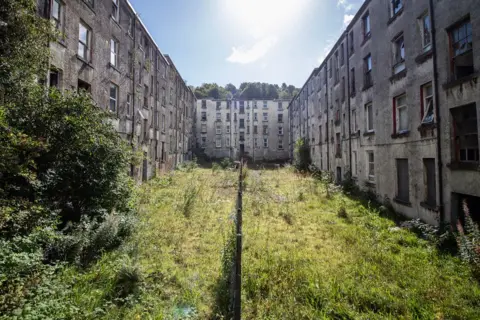 Urbandoned
UrbandonedThe run-down estate has in recent years become a magnet for urban explorers and photographers, forcing the authorities to step up security patrols and issue danger warnings.
Comparisons have often been made with the Ukrainian city of Pripyat, abandoned after the 1986 explosion at the Chernobyl nuclear plant led to a huge radiation leak.
Clune Park was first described as Scotland's Chernobyl more than a decade ago, and the name has stuck. Local politicians say it was an easy badge to apply to the area because of its desolate nature.
Beyond superficial appearances, though, their stories are very different.
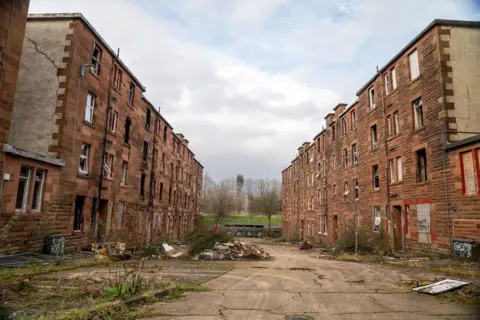
The red sandstone-fronted tenement blocks radiating off the town's Robert Street were built just after World War One by shipbuilder Lithgows to house its workforce.
Back then the waterfronts of Port Glasgow and neighbouring Greenock were filled with shipyards.
It was densely packed housing - 430 bedsits and flats, mostly in four-storey blocks - but there was a church, a school, local shops and a sense of community.
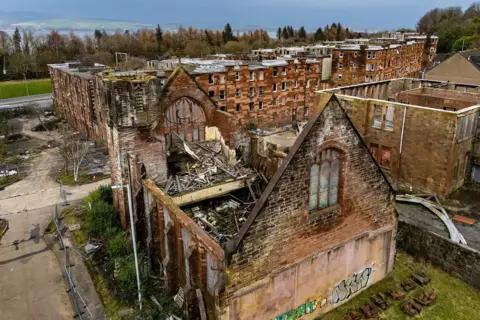
Former resident Karen Thomson and her husband Allan bought their first flat together as a married couple in Wallace Street in 1992, and stayed for six years.
"It was lovely - the neighbours were nice. It was a nice area, it was very friendly - everybody knew everybody," recalled Karen.
"It was very busy and the houses were sought after. It was very hard to get one of the houses in the area."
But Clyde shipbuilding had long been in decline, people were moving out and the cheap flats were increasingly bought up as rental investments.
Karen said: "The area was starting to fall down, they weren't keeping maintenance on it - the area started going to pot. I don't think they were putting money into it."
Clune Park fell into a spiral of decline, with property values plummeting further as it acquired a reputation for drug use and crime.

Retired forestry worker Marshal Craig, 73, is one of a handful of remaining residents.
He's lived at Clune Park for 20 years and his current rented flat on the edge of the estate is in far better condition than most. He describes it as the "posh end".
Some years ago he was hospitalised from smoke inhalation caused by one of the frequent deliberate fires in the abandoned buildings.
But as a keen reader, guitar player and nature lover, he values the quietness.
"There's seventeen different species of tree across the road," he said.
"At night you've got the foxes and owls and all the rest of it. I love that."
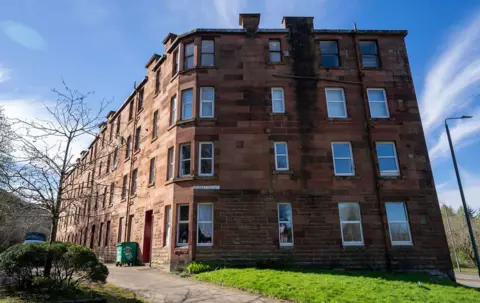
His block is not yet scheduled for demolition and his landlord is in no hurry to sell, so for the moment Marshal is staying put.
His home is well-decorated, boasts a large bay window and a Chesterfield sofa - all in stark contrast to the dereliction of the empty flats just a stone's throw away.
"People go how can you live there, are you not scared?" he says.
"I'm not scared. I'm a big guy - or I used to be. It suits me but it doesn't suit everybody and it doesn't suit the council."
A regeneration plan drawn up more than a decade ago proposed total demolition and rebuilding but ran into the buffers when some owners mounted a successful legal challenge.
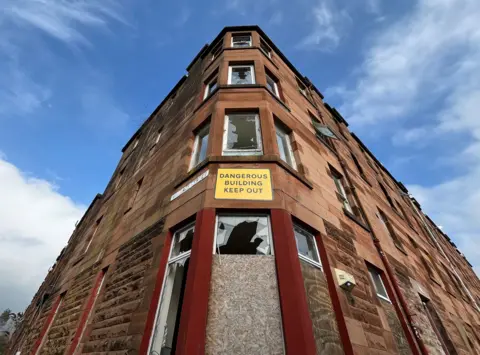
Since then the council has steadily bought up the flats to the point where it now owns about two thirds of the properties.
The first phase of demolition will see the church, the school and 15 of the 45 tenement blocks taken down, 138 flats in total - but the plan is for them all to go eventually.
The former Clune Park Primary School is one of the oldest buildings on the site, founded in 1887 - the year of Queen Victoria's jubilee.
Busts of Victoria and Prince Albert jut out from either side of the doorway, while higher on the wall is the Port Glasgow coat of arms, a three-masted sailing ship and the Latin motto "Ter Et Quater Anno Revisens Aequor Atlanticum Impune".
It translates as "Three and four times a year revisiting the Atlantic with impunity" - a reference to the ships that once fetched huge logs from Canada, to be seasoned in the "timber ponds" of the Clyde before being used for shipbuilding.
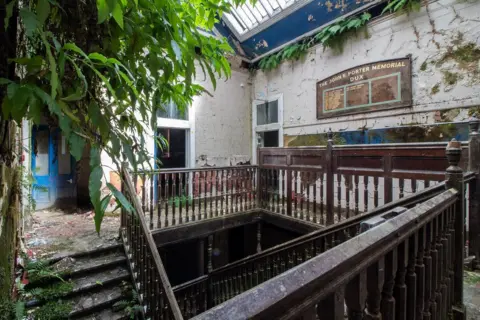 Urbandoned
Urbandoned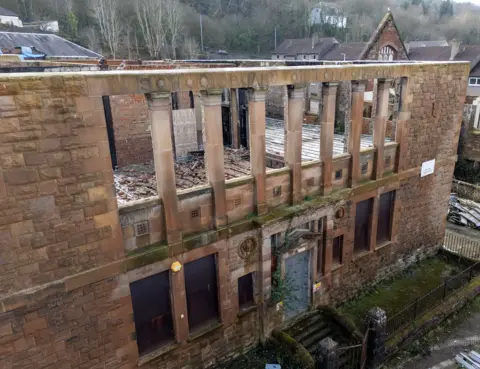
The demolition contractors say they will try to preserve the best stonework features by removing them by hand.
When the school closed in 2008, former pupils reminisced on social media about the grand staircase, the comforting smell of wooden floors and favourite teachers.
The building is B-listed - meaning it has regional importance.
Under the council's original regeneration plan, the frontage would have been retained and the site developed into an energy centre, providing low emission heating.
But a fire in 2023 gutted the school and it is now deemed beyond repair.
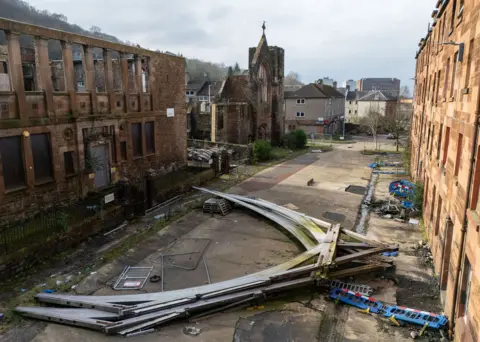
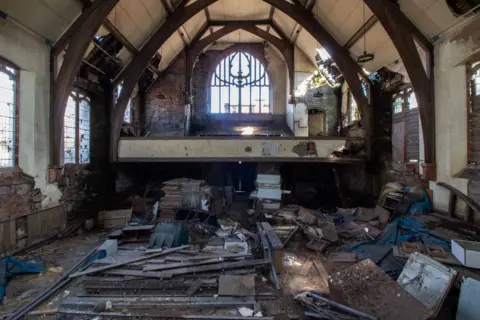 Urbandoned
UrbandonedNext to the school stands the shell of Clune Park Church, built in 1905 from red sandstone in the late Gothic "Modern Movement" style of architecture.
It has an ornate art nouveau-style window and, like the school, is B-listed by Historic Environment Scotland.
But the building's decay is now so far advanced, permission has been granted for demolition. The roof is long gone and huge timber roof trusses that once supported it have been stacked up in the street outside.
The Clune Park tenements are unusual in the west of Scotland in that they have flat concrete roofs which the council says are suffering from "corrosion swelling".
Inverclyde Council leader Stephen McCabe says back in the 1990s refurbishment was considered but no funding was available and a complete rebuild was thought better value.
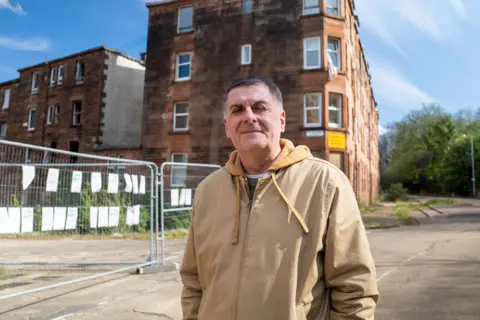
But he says the council has faced a long "war of attrition" to identify owners and buy up the properties, with valuations often coming in at just a few thousand pounds.
Ultimately the plan is to replace the 430 flats with 165 new affordable homes with the investment coming from a social landlord.
"The start of the demolition will be a real sign that we're getting there and we will ultimately demolish all of those properties," said McCabe.
"That will be a day for celebration".
But with around 100 flats still in private hands there's no clear timescale for when that will happen.
The demolition contractors expect to start taking down the first buildings later this month.
While it marks the beginning of the end for "Scotland's Chernobyl" it may be some time yet before a new Clune Park rises from the rubble.
